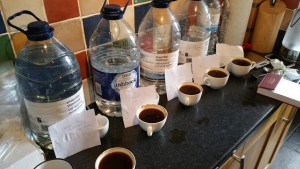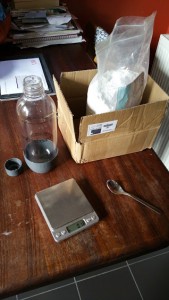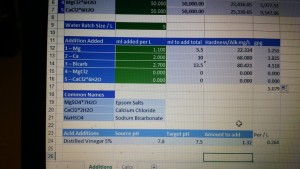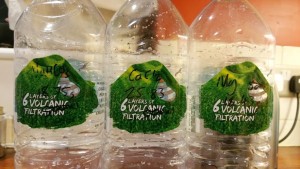Dissolved Minerals in Water and Their Effect On Coffee
Over the past 18 months I’ve done a fair bit of testing with various waters, both off the shelf mineral waters as well as hundreds of variations of my own homemade brew waters. More and more research is now being carried out of the effects of water on coffee and this is a fantastic thing however there is still a long way to go.
There is currently a bit of gap regarding the effects of different dissolved compounds in the water and their effect on the flavour and texture of the drink. I’m going to have a stab at it based on my testing. Like almost anything in the coffee world this is not planned as some definitive guide, it’s merely my thoughts basked on those 18 months of testing.
Hardness (Calcium)
Calcium Hardness is quite an important measure of your brew water and it represents the levels of Calcium and Magnesium in the water. It technically also includes Sodium and Potassium however they have a lower binding energy and can usually be ignored. The recent studies by Maxwell Colonna-Dashwood and Christopher Hendon show that Calcium Hardness is key to extracting the tasty compounds out of coffee.
My preferred brew water usually has around 100-200ppm Calcium Hardness as ppm CaCO3
Calcium vs Magnesium
Calcium gives a big creamy body and increased mouthfeel which I love. I’m not a fan of brew water that doesn’t contain it. Magnesium has a lower body but increased sweetness. I like these two to be balanced, usually in the favour of Calcium, maybe 60/40 ratio in ppm as CaCO3.
Calcium Carbonate
Seems to increase the body, balance and mouthfeel of the resulting coffee, quite often the resulting coffee ended up with a creamy mouthfeel which most people I tested with found highly desirable. This is my preferred base for brew water, without it everything seems to be lacking so I always build on top of it and love the results. It’s the cause of scale so you have to be careful as it doesn’t really dissolve in water and is also the cause of scale in coffee machines so you need to ensure that excessive amounts are not used
Sea Salt
It’s around 70% Sodium Chloride and the rest is made up from other common compounds such as Potassium Chloride and other naturally occurring minerals. The result of adding just a small amount of this to my brew water resulted in an increased perceived sweetness over the same water without. I now add a small amount of posh sea salt to all of my brew water and love it.
Chlorides (Calcium and Magnesium)
Chlorides seem to enhance body, creaminess and sweetness in coffee. I find this desirable however in high concentrations it can corrode metal so again usage needs to be monitored carefully.
Sulphates (Magnesium in particular)
Sulphates have always had a negative impact on coffee for me. I originally used to use Epsom Salts (magnesium sulphate hexa-hydrate) in my water and couldn’t work why the results weren’t really agreeable. I get slight increase in perceived bitterness but always ended up with a fake, astringent sweetness which I’d compare to the effect that off the shelf artificial sweeteners have for me. I don’t like it and I don’t use it in my brew water any more.
TDS
A lot of people talk about TDS and there are quite a few posts that now say that this is irrelevant and you need to measure hardness, well I don’t really agree. For me the following is true
TDS below 100 usually results in an unbalanced brew and can be astringent
TDS above 300 is usually heavy and dull muddled, muted flavours and aromas
TDS between 120-220 is my ideal range, usually towards the top-end. I find that water that is in this zone and that has a good balance of other minerals give a balanced, flavoursome and aromatic cup of coffee.
pH / Alkalinity
More the result of dissolved compounds but I think that it does have a big impact on coffee and as such is relevant here. It’s also worth noting that pH on its own does not tell you much about the end result in the cup, you also need to take Bicarbonates/Carbonates (alkalinity) into consideration as this will ultimately determine your brew pH. Coffee is quite an acidic drink and during the extraction you need to maintain a stable pH, if your Bicarbonates are too low then the pH will spike and you will end up with a highly acidic drink that will taste unbalanced.
I usually aim for a starting pH of between 7.5 and 6.5 with a Bicarbonate level of around 50ppm to 80ppm. I find that a starting pH much above 7.5 results in a very dull cup with low acidity and low aromatics. I’ve not tested anything below 6.5 as the water make-up to achieve this value would not be suitable for coffee in many other ways.
Carbonates vs Bicarbonates
I tried making brew water with Bicarbonates (Sodium Bicarbonate to be specific) and whatever I did I found that the resulting beverages were unpredictable for what of a better word. Sometimes they tasted great and sometimes they didn’t, they had a tendency to become unbalanced and not to my liking. I much prefer my current brew water which is made from Calcium Carbonate (for the reasons mentioned above), it just works for me plus it’s easier to control the Chloride/Sulphate levels in the brew.





12 Comments. Leave new
Thanks for sharing… Given that you prefer Magnesium Chloride to Sulphate, do you have a recommendation for how much to use to create a concentrate, and then amount to use for the additions technique, rather than the sodastream technique? I need to make bigger batches of water for cupping, but the maths and chemistry side of things is beyond me so if you could help I’d appreciate it!
So how do you add Magnesium if you don’t use MgSO4?
Hi Will, I much prefer Magnesium Chloride (MgCl2*6H2O to be precise). La Marzocco recommend not going over 50ppm of chloride ions for espresso due to the potential of boiler pitting so just keep that in mind.
I just wanted to say ive spent the last few hours going over your blog. Very interesting thanks for all the information
For those of us who are math challenged, do you have a formula that I could add to a gallon of distilled water?
Hi there,
Which method are you using to make the water?
Cheers
Spence
I went with calcium chloride because calcium carbonate is not water soluble. Could you explain how you would be able to dissolve it.
Hi Julian,
Thanks for getting in touch. Answer is here
https://grindscience.com/2015/08/making-water-for-coffee-sodastream-method-best-recipe-so-far/
Thanks for sharing man, I totally agree with you. Recently, I tried adding 1 gram sea salt into 100mL water, and then dilute them into total volume 1L to use for brewing coffee. They truly make my old coffee (1 year+) taste much better than using my normal filtered water, robusta no less.
Hello, I was wondering if you noticed if dissolved silica has any effect. Some bottled waters have much more than others.
[…] so for that reason we don’t recommend using them. If you want to try using these, you can carbonate the water using a sodastream to make them dissolve, but we find there are easier ways to get similar […]
[…] Surprisingly, a little bit of hardness is better for coffee brewing water. Thus, the standards don’t recommend softened or distilled water. This recommendation is crucial, despite distilled water preventing a scale build-up inside your coffee machine. The minerals interact with the coffee to give it a creamier body and enhanced mouthfeel (3). […]